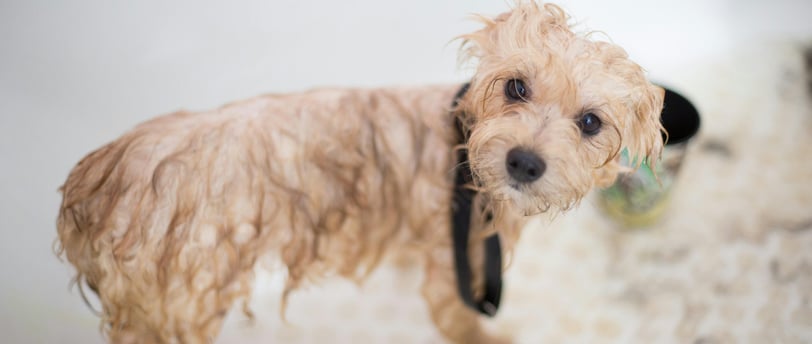Basic Dog Grooming Essentials: A Guide for Every Dog Parent
🐾 Want to keep your furry friend looking and feeling their best? This guide covers all the essential pet grooming tools and tips you need! From brushing and bathing to nail trims and ear care, learn how to make grooming a stress-free, bonding experience for you and your pet. ✂️🛁 #PetGroomingTips #HappyPets #PetCareEssentials
POPULAR BLOGSHYGIENE & GROOMING
11/17/20243 min read


Grooming is a vital part of keeping your pet happy, healthy, and comfortable. Whether you have a playful puppy, a sassy cat, or another furry friend, regular grooming helps maintain their hygiene, prevents health issues, and strengthens your bond. Here’s a guide to the basic grooming essentials every pet parent should know about.
1. Brushing Tools
Why It’s Important: Regular brushing removes loose hair, prevents mats, and distributes natural oils for a healthy coat.
What to Use:
Slicker brush: Great for long-haired pets prone to tangles.
Bristle brush: Ideal for short-haired breeds.
Undercoat rake: For pets with thick double coats, like Huskies or Maine Coons.
Pro Tip: Brush your pet at least once a week—or more often during shedding seasons.
2. Nail Clippers or Grinders
Why It’s Important: Overgrown nails can cause pain and affect your pet’s posture or mobility.
What to Use:
Scissor-style clippers: For larger pets or thick nails.
Guillotine-style clippers: Best for small to medium pets.
Nail grinders: An alternative for pets who dislike clippers, offering smoother edges.
Pro Tip: Trim your pet’s nails every 3–4 weeks, and avoid cutting into the quick (the sensitive blood vessel inside the nail).
3. Shampoo and Conditioner
Why It’s Important: Pets need regular baths to keep their coat clean and their skin healthy.
What to Use:
Pet-specific shampoo: Avoid human products, as they can irritate your pet’s skin.
Hypoallergenic options: Ideal for pets with sensitive skin.
Conditioner: Keeps the coat soft and manageable, especially for long-haired pets.
Pro Tip: Bathe your pet every 4–6 weeks unless they get dirty more often. Overbathing can strip their skin of natural oils.
4. Ear Cleaning Supplies
Why It’s Important: Regular ear cleaning prevents infections, especially for pets with floppy ears or those prone to wax buildup.
What to Use:
Pet ear cleaner: A vet-approved solution.
Cotton balls or gauze: To wipe away dirt and debris.
Pro Tip: Clean your pet’s ears once a month—or weekly if they’re prone to ear issues. Avoid using cotton swabs, as they can push debris further in.
5. Dental Care Items
Why It’s Important: Oral hygiene is crucial for preventing bad breath, gum disease, and other health problems.
What to Use:
Pet toothpaste: Available in pet-friendly flavors like chicken or peanut butter.
Toothbrush or finger brush: Designed for your pet’s mouth.
Dental chews or toys: A great supplement to brushing.
Pro Tip: Brush your pet’s teeth 2–3 times a week for the best results.
6. Grooming Wipes
Why It’s Important: Perfect for quick cleanups between baths or after messy adventures.
What to Use:
Pet-safe wipes: For wiping paws, fur, and even their face.
Hypoallergenic options: For pets with sensitive skin.
Pro Tip: Keep a pack of wipes handy for on-the-go cleaning after walks or playtime.
7. Grooming Scissors and Trimmers
Why It’s Important: Regular trims help keep your pet’s coat neat and prevent matting.
What to Use:
Round-tipped scissors: For trimming around the face, paws, and tail.
Electric trimmers: For pets that need regular shaving or trimming.
Pro Tip: Always trim a little at a time to avoid accidents, and ensure your pet is calm and comfortable.
8. Towels and Dryers
Why It’s Important: Proper drying after baths prevents your pet from catching a chill and reduces the chance of skin infections.
What to Use:
Absorbent pet towels: Designed to dry fur quickly.
Pet-safe dryers: Quiet and gentle to avoid scaring your pet.
Pro Tip: Use a low heat setting on dryers to protect your pet’s sensitive skin.
9. Flea and Tick Prevention Products
Why It’s Important: Grooming isn’t complete without protecting your pet from parasites.
What to Use:
Flea combs: To check for fleas and their eggs.
Preventive treatments: Shampoos, sprays, or monthly treatments recommended by your vet.
10. Grooming Table or Mat
Why It’s Important: A stable surface makes grooming easier and safer for both you and your pet.
What to Use:
Non-slip mats: For small pets or occasional grooming.
Grooming tables with restraints: For larger pets or regular grooming sessions.
Pro Tip: Make grooming a positive experience by rewarding your pet with treats and praise.
Final Thoughts
Grooming isn’t just about keeping your pet looking good—it’s about their overall health and comfort. By investing in the right tools and establishing a grooming routine, you’ll not only keep your pet happy but also strengthen your bond.
